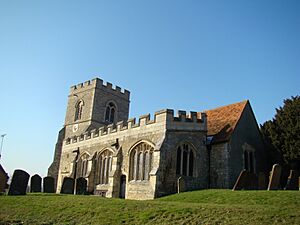All Saints Church, Loughton facts for kids
All Saints' Church is a special kind of church in Loughton, Milton Keynes, England. It's an ecumenical church, which means it welcomes people from different Christian groups to worship together.
Contents
A Look at the Church's Past
How Old is All Saints' Church?
People first wrote about a church in Great Loughton way back in 1219. The building you see today started being built in the early 1200s. Long ago, there were actually two separate churches in two different areas called Little Loughton and Great Loughton.
Building Through the Centuries
The main parts of the church, like the chancel (the area around the altar) and the nave (where the congregation sits), were likely built in the early 1200s. Over time, many changes were made. Around 1250, new windows and doorways were added.
Later, in the late 1400s, more parts were built. These included the south chapel, an aisle (a side section), the porch, and the tall tower. The roof of the nave was also replaced around this time. The church has been repaired and updated several times, including in 1700, 1851, and 1886, when new seats were put in.
Inside the Church: Special Features
The chancel has a large east window that lets in light. There's also a blocked-up window on the north side. On the south side, an arch connects to the chapel.
In the nave, there are windows from different periods. One window on the north side was blocked up, and another was made taller around 1700. The south doorway, built around 1400, has a special arch. The tower arch, which is very thick, connects the nave to the tower. The nave has an old wooden roof from the late 1400s.
The South Chapel and Tower
The south chapel and aisle are one long building. They have several large windows from the late 1400s, which let in lots of light. The roof of this section is also from the late 1400s and has carved decorations. The porch, which is a bit older than the aisle, used to have a pointed roof over its entrance.
The church tower has three main levels and a decorated top. Even though its walls are very thick (about 5 feet 5 inches!), a strong support was added to the west side of the tower because it might have shown signs of weakness after it was built. This support goes right through the wall and partly blocks a window and a doorway.
Old Treasures Inside
The church has some interesting old items. The font, used for baptisms, is octagonal and likely from around 1700. On the chancel floor, there's a brass plaque showing a priest named Hugh Park, who died in 1514. There are also monuments on the walls to members of the Crane family from the 1600s.
In the tower, you can find a large, iron-bound box from the late 1500s. This was a "poor-box" where people could donate money to help those in need. In the south chapel, there are two carved wooden panels. You can also see some old pieces of stained glass on the north wall of the nave. At the east end of the chancel, there's a painting by Gonzales showing Jesus and two disciples. This painting was given to the church in 1833.
The Church Bells
The tower holds a set of six bells. Two of them are newer. The third bell was made in 1631. The fourth and fifth bells are very old, made around 1460. The largest bell, called the tenor, was made in 1590.
Interesting Facts and Stories
A Medieval Mystery
In 1378, something unusual happened. The priest of Little Loughton, William Capel de Sapcote, was found dead on the road. An investigation found that the priest of Great Loughton, John Gervyes, had killed him with an arrow. The arrow was worth a very small amount of money at the time, but the village of Great Loughton was fined for the value of the bow and arrow. Later, in 1408, the two areas, Little and Great Loughton, joined together to form the single parish we know today.
All Saints' Church Today
Modern Updates and Community Use
All Saints' Church has been updated to be more useful for the community. The flooring and seating were refurbished, which means the main part of the church can now be used for many different activities, not just services.
The church also has a room next to it. This room is used by the children's Sunday club during church services. It's also where people gather for refreshments after services. Both the church building and this adjoining room can be rented by local groups and businesses for their own events.
All Saints' Church is part of a larger group called the Watling Valley Ecumenical Partnership. This partnership helps different Christian churches work together in the local area.
Interesting Facts About All Saints'
In 1408, the two separate areas of Little Loughton and Great Loughton joined together to form the single parish we know today.


